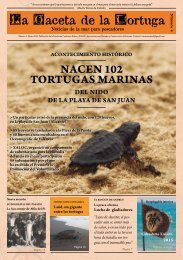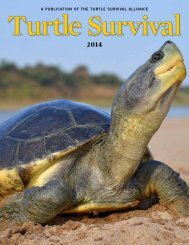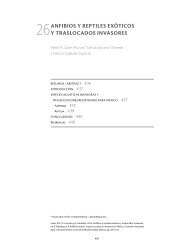tsrp63entire
tsrp63entire
tsrp63entire
You also want an ePaper? Increase the reach of your titles
YUMPU automatically turns print PDFs into web optimized ePapers that Google loves.
Archey’s frog is currently restricted to two regions in the North Island: the Coromandel<br />
Peninsula and a 6-km 2 area of Whareorino Forest, west of Te Kuiti. In both of these areas, it<br />
occurs sympatrically with Hochstetter’s frog. The total population size is estimated to be<br />
5000–20 000 individuals. In 2006, 70 Archey’s frogs were translocated from Whareorino Forest to<br />
Pureora Forest to establish an additional mainland population after the amphibian chytrid fungus<br />
was detected in the Whareorino population. However, although breeding has been observed each<br />
year, only a low number of the original individuals has been detected and it is still too early to<br />
determine whether the translocation was successful.<br />
Hochstetter’s frog currently has the most widespread distribution, being found in scattered<br />
populations over an extensive area of the North Island. Its distribution ranges over the<br />
Whangarei District and Great Barrier Island (Aotea Island), through the Waitakere and<br />
Hunua Ranges, down the Coromandel Peninsula and into the northern Kaimai Range, from<br />
Whareorino in the west, through isolated populations in the central North Island (Maungatautiri<br />
and Rangitoto), and throughout the Eastern Bay of Plenty and Raukumara Ranges. The total<br />
population size is estimated to be c. 100 000 individuals.<br />
Maud Island frog is presently only found naturally on Maud Island, a small predator-free island<br />
in the Marlborough Sounds. The population is mainly restricted to 16 ha of native bush and has<br />
been estimated at 25 000–30 000 individuals (Le Roux & Bell 2007; Bell & Pledger 2010). The<br />
species has also been translocated to restored habitat at a second site on Maud Island<br />
(1984–1985), to predator-free Motuara Island (1997) (Tocher & Pledger 2005), to Long Island<br />
(2005) and to Zealandia (formerly named Karori Wildlife Sanctuary), a fenced mainland site<br />
(2006). However, although juvenile frogs have been found during post-release monitoring,<br />
translocation success is difficult to determine in the short term.<br />
The only naturally occurring Hamilton’s frog population presently consists of less than<br />
300 adult frogs on Stephens Island in Cook Strait, where they are limited to a rock tumble<br />
(c. 600 m 2 ) on the island summit (Newman 1990; Tocher et al. 2006). Hamilton’s frogs were<br />
translocated to an additional site on Stephens Island in 1992 (Brown 1994) and to a second<br />
island in the Marlborough Sounds (Nukuwaiata Island) in 2004 and 2006. However, as with the<br />
other native frog species, although there is evidence of breeding, judging whether the frogs have<br />
successfully established remains a challenge.<br />
3.1.5 Agent(s) of decline and threats<br />
Agents of decline for native frogs have not been conclusively demonstrated, particularly at<br />
the population level, and in some cases are speculative. Primary threats are considered to be<br />
predation by rats (Rattus spp.) (known predators of native frogs); habitat loss and modification;<br />
disease; toxins; herbicides; and climate change. Introduced frogs (Litoria spp.) are also known to<br />
prey on native frogs, and it has been suggested that other mammals such as mice<br />
(Mus musculus), stoats (Mustela erminea), hedgehogs (Erinaceus europaeus), possums<br />
(Trichosurus vulpecula) or pigs (Sus scrofa) may affect native frog populations; however, the<br />
significance of these species as predators and/or habitat modifiers has not yet been determined.<br />
Domestic cats (Felis catus), which are also known predators of frogs, are another potentially<br />
significant threat as subdivisions adjacent to, or within, native frog habitat increases (Bell 1994;<br />
Thurley & Bell 1994; Newman 1996; Bell et al. 2004a).<br />
Predation by rats is suspected to be an important agent of decline and a primary threat for two<br />
main reasons. Firstly, dead Archey’s frogs displaying bite marks characteristic of rat predation<br />
have been found in the wild (Thurley & Bell 1994). Secondly, two species of native frogs<br />
(Maud Island and Hamilton’s) are restricted to rat-free islands, despite subfossil remains having<br />
been found on the mainland where rats are now present.<br />
Habitat loss and modification is also considered to be an important threat and an agent of<br />
decline (Bell et al. 2004c). Although Hochstetter’s frog has persisted in some landscapes modified<br />
by forestry, the long-term survival of these populations is uncertain.<br />
6 Bishop et al.—Native frog recovery plan, 2013–2018





